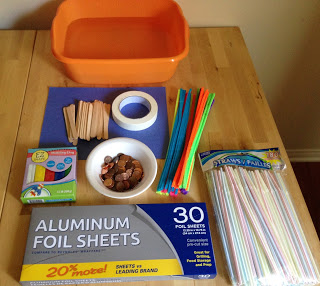Do you ever feel your class has lost that loving feeling? You know what I’m talking about – that buzz of I-love-learning electricity that signals to all that your class is THE place to be! Design challenges – STEM and otherwise – are a great way to get back on track. In a test-weary world, teach with purpose, teach with passion, teach with DESIGN!
In my classrooms, I gravitate toward two kinds of design challenges: STEM and what I call “Traditional.” The two have far more in common than not, as shown in the chart below. As a caveat, my view of traditional design might differ from others. This post uses these commonalities to do a little myth-busting, and an upcoming post will offer up tips and go into greater detail to contrast STEM and “Traditional” Design Challenges.
1. It’s just play; there’s no rigor
 |
| Build a Boat Challenge |
It is play, but it’s also enormously productive! The problem-solving, critical thinking, and application of knowledge is at extremely high levels during Design Challenges. Fun, engaging, and meaningful are by-products of Design is done right, and it’s nothing to fear or apologize for. Fun & rigorous aren’t mutually exclusive!
A strong approach is to conduct a challenge as an opening activity to a unit of study. This sets the foundation, providing the context and motivation for learning. Next, teach related content lessons and/or have students research. Then conduct at least one additional iteration of the challenge to give students an opportunity to apply their learning.
 |
| Build a Boat Challenge Materials |
2. Materials are too expensive
As with so many things, it’s as expensive as you let it get. The most important feature of Design Challenge materials is their malleability. I’ve used an awful lot of foil, pipe cleaners, tape, and newspaper over the years. I’ve also included special, pricier materials from time to time: Crayola Model Magic, sequins, feathers, etc.
Generally, I look for materials inspiration at my local Dollar Tree, and I ask students to bring in “clean trash” (water bottle lids, packing materials, cardboard etc.). There is absolutely no reason Design challenges should lighten your wallet!
3. Too much prep
 |
| Build a Boat Lesson Guide |
I would argue that you can pretty easily conduct a challenge without much prep, and it would be engaging and require students to think critically and problem-solve. It would be a valuable exercise on those counts alone.
However, to get the full value from a Design Challenge, there is some work involved. Probably the most important prep work is the construction of your criteria and constraints list (more on this in next post). This is your opportunity to bake in content standards you will teach in follow-up lessons. Finding the opportunities in your content standards takes some prep, but after one or two challenges, it won’t take long to do.
There’s also lots of lesson plan help available around the web. The photos above are from this lesson pictured (left) and there are fun ideas available at the Odyssey of the Mind site as well.
4. Takes too much time
Part of the beauty of using a criteria and constraints list is that you can constrain on time in order to complete challenges in a set time frame. If you commit to using Design Challenges in your room, it will be helpful to set up some materials procedures for getting started and cleaning up.
For the actual Design activity, it can be conducted as a one-off with very little prep and you will find, the creativity, critical thinking and problem-solving involved in Design justify the time. Going a step further to tie in content lessons and Design in multiple iterations do require additional time, but the juice is worth the squeeze!
~~~~~~~~~~~~~~~~~~~~~~~~~~~~~~~~~~~~~~~~~~~~~~~~~
Related Posts:
STEM vs. “Traditional” Design Challenges
St. Patrick’s Day STEM Olympics






